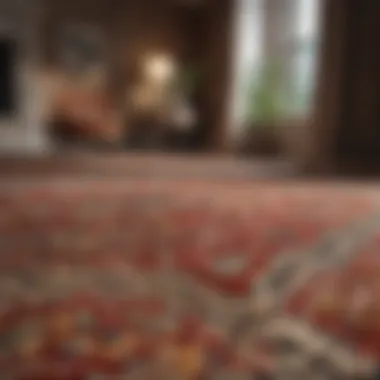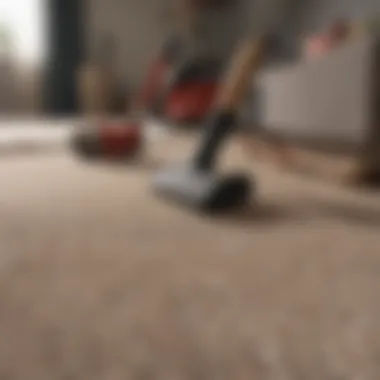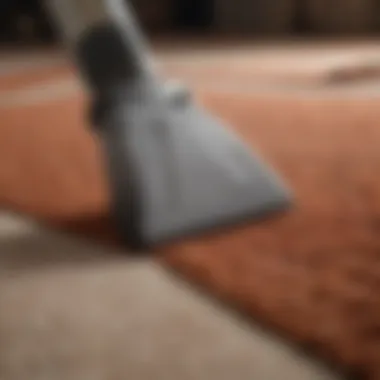Understanding the Cost of Carpet Installation


Intro
Key Insights and Trends
When it comes to interior design, flooring trends can greatly influence the costs associated with installing new carpets. Understanding these trends can also help homeowners align their choices with market preferences, potentially enhancing property value.
Current trends in interior design
Currently, sustainable and eco-friendly materials are gaining traction among consumers who prioritize environmental impact. Brands such as Shaw and Mohawk are offering carpets made from recycled materials, which often come with a premium price tag but align with the growing trend of sustainability. Additionally, textures like frieze and loop carpets are seeing popularity due to their wear resistance and ability to hide dirt, making them practical choices for high-traffic areas.
Innovative features in carpet technology
Technological advancements also affect the cost. Carpets with stain-resistant features or improved durability may cost more upfront. However, they can save money on maintenance in the long run. Features such as built-in antimicrobial treatments can add to the overall expense but can be worthwhile investments for families.
Practical Considerations
To effectively navigate carpet installation costs, considering practical aspects is imperative.
Preparation costs and labor considerations
Before installation begins, adequate preparation is essential. This might include removing old carpeting or flooring materials. Depending on the type of floor previously installed, this process can be labor-intensive, leading to higher costs. The labor rates can vary significantly based on the region and the experience of the contractors. Normally, skilled installers charge more due to their expertise, but quality of installation is key to flooring longevity.
Understanding your warranty options
Another vital factor is the warranty. Carpet warranties can vary widely based on the manufacturer, covering issues like fading or wear. Paying attention to these stipulations can prevent unexpected costs down the road. Some carpets come with lifetime warranties, while others may only cover a few years, impacting your long-term investment.
"Choosing the right carpet involves comprehending both the upfront and the long-term implications of your decision, including maintenance and warranty issues."
Epilogue
Overview of Carpet Installation Costs
When considering a new carpet, understanding the costs involved is crucial. The topic of carpet installation prices encompasses various elements that significantly impact the overall expenditure. This section aims to elucidate the primary components that contribute to the cost of carpet installation, making it clearer for homeowners and renters alike.
Prelude to Carpet Installation Pricing
Carpet installation pricing is not a one-size-fits-all matter. Many factors contribute to the final cost, including the type of carpet chosen, the room's layout, and the specifics of the installation process. Homeowners must appreciate that selecting a carpet is not just about the surface appearance; it also involves understanding the logistics and financial implications of laying it down.
The carpet market offers a diverse range of materials and styles. Each variant has its own price tag, influenced by factors like material quality, brand reputation, and market trends. Furthermore, the total cost of carpet installation involves more than just the price of the carpet material. Installation fees, labor costs, and additional preparations often lead to a significant increase in the estimated budget.
Typical Price Ranges for Different Carpet Types
When budgeting for carpet installation, it helps to know the general price ranges associated with various carpet types. Here are some common price categories:
- Synthetic Carpets: These are widely used due to their affordability. Prices generally range from $2 to $5 per square foot, making them suitable for various budgets.
- Natural Fiber Carpets: Wool and sisal carpets, for example, are more luxurious. They typically cost between $6 and $15 per square foot. The organic nature appeals to many consumers, although the base price is higher.
- High-End Carpets: Specialty materials, like silk or designer brands, may elevate costs even further—often exceeding $20 per square foot. Such options may be preferable for exclusive interior designs or high-value residencies.
Factors Impacting Carpet Installation Costs
Understanding the factors influencing carpet installation costs is essential for anyone considering a flooring project. The total expense extends beyond just purchasing carpet; it involves a variety of other elements. Key considerations include the type of carpet material, room size and layout, preparation and subfloor conditions, and the chosen installation method. Each factor contributes to the holistic cost of laying down carpet, affecting not only the initial outlay but also long-term maintenance and satisfaction with the final product.
Type of Carpet Material


Natural Fibers vs Synthetic Fibers
Natural fibers, like wool and cotton, and synthetic fibers, such as nylon and polyester, each have unique characteristics that influence selection. Natural fibers are often sought after for their aesthetic appeal and environmental benefits. Their breathability and comfort underfoot are also noteworthy traits. However, they tend to be more expensive and may require specific cleaning methods.
Synthetic fibers, on the other hand, offer durability and stain resistance. They are generally more affordable and versatile for various applications. Many homeowners prefer synthetic options for high-traffic areas due to their resilient nature. Ultimately, understanding these choices is crucial as they play a significant role in the overall cost of carpet installation.
Durability and Wear Ratings
Durability and wear ratings signify how well the carpet will withstand everyday use and environmental factors. High durability ratings indicate a carpet’s ability to maintain its looks and structure over time. This aspect is extremely beneficial when selecting flooring for homes with pets and children, as more resilient carpets may save costs associated with frequent replacements.
Conversely, lower durability ratings may result in frequent repairs or replacements, leading to higher long-term expenses. This factor is important when budgeting for carpet installation, as selecting a durable product can be a wise investment in the longevity of the flooring.
Room Size and Layout
Calculating Square Footage
Calculating square footage is a foundational aspect in determining total carpet cost. To accurately estimate the amount of carpet needed, homeowners must measure the length and width of each room. Multiply these dimensions to achieve the total square footage.
This calculation is particularly beneficial when budgeting because it enables potential buyers to understand the material needs. The greater the area, the more carpet is required, leading to higher costs.
Complexities in Laying Carpet
Complex room layouts may affect the installation process's overall cost. Rooms with many corners, angled walls, or built-in fixtures can increase labor time and complexity. These complexities may lead to additional charges, and homeowners should be aware that these aspects may require skilled labor, influencing the final price of installation.
Preparation and Subfloor Considerations
Cleaning and Repairing Subfloors
Before the new carpet is laid, proper preparation of the subfloor is essential. This includes cleaning and making necessary repairs, which can involve patching holes or replacing damaged areas. A sound subfloor can prevent future problems and ensure that the carpet lays flat and remains in good condition.
Investing time and resources in this aspect is crucial as it can prolong the carpet’s life. Neglecting this step might lead to costly repairs in the future, thus altering the anticipated budget.
Underlayment and Padding Requirements
Underlayment provides additional cushioning and can improve the comfort and lifespan of the carpet. Different types of underlayment materials come with varying costs and benefits. Padding thickness and quality affect not just comfort but also insulation and soundproofing capabilities. Higher-quality padding can enhance the performance of the carpet, which makes them worth considering during budgeting discussions.
Installation Methods
Glue-down vs. Stretch-in Methods
The installation method selected can significantly impact both cost and outcome. Glue-down methods involve adhering carpet directly to the subfloor, suitable for areas with high traffic. Stretch-in methods involve fitting the carpet over padding, secured to the floor with tack strips. While both methods have distinct advantages, glue-down options typically incur lower installation labor costs but may involve higher material costs due to adhesives.
Choosing the right method depends on various factors, such as the type of carpet and the expected foot traffic, and merits careful consideration for accurate budgeting.
Cost Variations by Method
Cost variations based on the installation method are notable. Glue-down installations may be cheaper in terms of labor but require more expensive adhesives. Conversely, stretch-in methods often lead to increased labor costs due to their complexity but may utilize less costly materials. Being aware of these differences is key in making financially sound decisions regarding carpet installation.
Labor Costs for Carpet Installation
Understanding labor costs is a crucial aspect of budgeting for carpet installation. They can significantly affect the total expenditure of your flooring project. Labor costs typically vary based on several parameters such as location, skill level of the installers, and the complexity of the job. Recognizing these costs can aid homeowners in making informed financial decisions regarding their carpet installation.


Understanding Labor Rates
Hourly Rates vs Per Square Foot Pricing
Labor rates can be categorized mainly into hourly rates and per square foot pricing.
Hourly rates involve paying workers for the time they spend on the job. This approach can be beneficial for projects with unpredictable time requirements. However, it may lead to unexpected expenses if the installation takes longer than initially estimated.
Conversely, per square foot pricing is simpler to comprehend and often preferred by homeowners. This method gives a clear calculation of how much you will pay based on the area being carpeted. It is easier to budget as you can estimate the total cost more accurately before the work begins. This pricing system is common in the industry because it aligns with project size, providing a straightforward approach to pricing.
Despite its clarity, the per square foot method might not cover all variables involved in the installation; hence, it's important to weigh its pros and cons carefully.
Regional Variations in Labor Costs
Labor costs can also differ significantly by region. Areas with a high cost of living often see higher labor rates than those in less expensive locations.
For instance, metropolitan areas like New York City or San Francisco typically have elevated labor costs compared to rural locations. The higher rates in urban centers often reflect the increased demand for skilled workers in a competitive job market.
Understanding these regional variations can aid you in planning your carpet installation budget. It's wise to obtain quotes from multiple local contractors to gauge reasonable rates based on your locality. With this approach, you can avoid being overcharged while ensuring quality work.
Choosing Between Professional Installation and DIY
Cost Comparisons and Implications
The decision to go for professional installation or to attempt a DIY project can greatly influence your total costs. Analyzing cost comparisons and implications is vital for rational decision-making.
Professional installation often comes with a higher upfront cost. This investment, however, guarantees that the work is done correctly and efficiently. You get the advantage of skilled labor without the potential pitfalls often encountered in DIY projects, such as improper measurements or finishing issues.
On the other hand, DIY can be a good way to cut costs if you have the appropriate skills and tools. However, consider the potential hidden expenses for mistakes or repairs, which could negate any savings. A clear understanding of both possibilities allows homeowners to balance budget limitations against the quality and longevity of their carpet installation.
Skill Requirements for DIY
Assessing the skill requirements for DIY installation is crucial. It's not merely about having the desire to save money; it involves understanding whether you possess the necessary skills.
Installing carpet involves precise cutting, fitting, and stretching to avoid issues like wrinkling or improper adhesion. If you lack prior experience, your DIY efforts may result in unnecessary frustration or, worse, costly errors.
Moreover, even if you are confident in your abilities, specialized tools may be needed. The cost of tools and potential errors could end up being more than hiring a professional. In summary, while DIY seems appealing, it requires a thorough evaluation of your skill level and the project demands to prevent overspending and dissatisfaction.
Additional Costs Beyond Carpet and Installation
When planning for carpet installation, it is crucial to recognize that the initial outlay for carpet and its installation is often just the beginning. Homeowners must consider several additional costs that significantly impact the total budget. Understanding these factors can help prevent unpleasant surprises and allow for better financial planning.
Padding and Underlayment Expenses
Selecting the right padding and underlayment is essential for enhancing the performance and longevity of your carpet. Padding acts as a buffer between the carpet and the subfloor, adding cushioning and improving comfort underfoot. It also helps with insulation and sound absorption. The cost of padding varies widely based on material quality and thickness.
For example, dense foam padding may range from a few cents to a dollar per square foot. This cost adds up quickly with larger areas. Investing in quality padding can lead to better wear and tear resistance, ultimately saving money in replacement costs. It is advisable to consult with professionals to find the most suitable padding for your specific carpet type and requirements.
Removal of Old Flooring
If you are replacing an old carpet or different type of flooring, the removal process itself can incur significant costs. Professional services can charge anywhere from $1 to $3 per square foot for removing existing flooring. DIY removal may save costs, but it can be labor-intensive and time-consuming, coupled with the potential risk of damaging the underlying subfloor.


Old flooring removal not only carries financial consequences but might also lead to additional payments related to disposing of the old material, especially if it includes hazardous substances such as asbestos. Therefore, properly assessing the removal costs beforehand is important in budget preparation.
Transportation and Delivery Fees
Lastly, transportation and delivery fees can add hidden costs to your project. Many carpet retailers or installers charge for delivering the carpet to your home, and these rates can vary tremendously based on location and the distance from the store. Homeowners might find themselves facing fees ranging from $50 to several hundred dollars, depending on the scale of the installation.
Furthermore, if you are purchasing bulky underlayment materials, these might also incur additional delivery costs. Understanding these expenses upfront allows homeowners to make informed decisions about where to purchase materials, potentially selecting local suppliers to minimize costs.
In summary, taking into account these additional costs related to padding, removal of old flooring, and transportation can provide a more accurate estimation of the total expenses for carpet installation. Planning for these elements ensures a smoother installation process and helps keep the project within budget.
Long-term Financial Considerations
Understanding long-term financial considerations is essential when evaluating the cost of carpet installation. This section addresses how carpet choices can influence future expenses and the overall investment in a home. Planning ahead can prevent financial surprises down the line and contributes to a well-informed purchasing decision.
Maintenance Costs Over Time
Regular Cleaning and Upkeep
Regular cleaning is an integral part of maintaining carpet. This includes vacuuming, shampooing, and occasional deep cleaning. The main characteristic of regular cleaning lies in its ability to prolong the life of carpet. Routine maintenance keeps the fibers looking new and enhances the overall appearance of the flooring.
The benefit of keeping a cleaning schedule is that it minimizes the need for replacement. While there is an upfront cost associated with purchasing cleaning supplies or services, this investment can greatly reduce long-term costs. Neglecting regular upkeep, however, can lead to embedded dirt and stains that may require more intensive cleaning methods or even replacement. Overall, regular cleaning and upkeep underscores the importance of an ongoing commitment to carpet care.
Possible Repair or Replacement Fees
Possible repair or replacement fees represent significant future costs that homeowners must consider. Damaged areas due to wear and tear may need patching, while stained carpets often require replacement. The characteristic of these fees is their unpredictable nature; homeowners may face unexpected expenses unless appropriate preventive measures are taken.
The unique feature of repair or replacement costs is their variability. Different carpet materials display distinct durability levels, influencing how often repairs or replacements are needed. Higher quality carpets typically incur fewer repair fees but might have a higher initial cost. Homeowners must weigh these options to make financially sound decisions regarding their flooring. Therefore, properly maintaining carpets can significantly mitigate potential future expenditures.
Impact on Resale Value
Carpet Quality and Home Classification
The quality of carpet chosen can directly affect a home's resale value. Higher-quality carpets enhance perceived value, appealing to potential buyers. The distinction of carpet quality is important as it often reflects not just aesthetics but also durability and comfort. Investing in quality carpet can lead to a more favorable market impression.
However, there are trade-offs associated with premium choices. While high-end materials may yield higher resale prices, they also demand greater upfront expenses. A sound understanding of the intersection between quality and potential buyers' preferences can guide homeowners in making choices that positively affect resale value.
Market Trends Influencing Value
Market trends represent another significant factor impacting resale value. Consumer preferences evolve over time, influencing not just the materials but also colors and styles of carpet. Keeping current with market demands ensures that homeowners make informed decisions before installation.
The unique feature of market trends is their dynamic nature. Staying informed can be beneficial for homeowners, as it may result in choosing styles that remain in demand or that are expected to become popular. On the downside, trends can rapidly change, which might leave a homeowner with an outdated carpet style when selling their home. Being aware of these fluctuations is crucial for optimizing potential resale value.
The End
Summarizing Key Takeaways
To summarize, here are the key points to consider regarding carpet installation costs:
- Material Matters: Different carpet types bring different price ranges and durability. Choose wisely based on your needs and lifestyle.
- Size and Layout: The room's size and its shape directly influence the amount of carpet needed, affecting the overall cost.
- Preparation is Key: Don't overlook subfloor preparation and necessary underlayment, as these can add to your expenses.
- Labor Costs: Understanding both hourly and per square foot pricing will help you assess whether to hire professionals or go the DIY route.
- Hidden Costs: Always factor in additional expenses such as removal of old flooring and transportation fees into your budget.
"Budgeting for carpet installation requires a thoughtful analysis of all contributing factors to avoid unexpected costs later on."
Final Thoughts on Budgeting for Carpet Installation
When budgeting, it is essential to take a detailed approach. A well-constructed budget allows for better decision-making. Here are considerations to think about:
- Conduct Thorough Research: Before purchasing carpet, review various brands and materials to ensure you're getting value for your money.
- Get Multiple Quotes: If opting for professional installation, gather multiple estimates to find a fair price. Different installers may have varying costs.
- Factor in Lifespan: Some carpets may cost more upfront but offer extended longevity, making them a better investment in the long run.
- Plan for Maintenance: Integrate cleaning and upkeep into your budget. Regular maintenance can extend the life of your carpet and save money over time.
- Stay Flexible: Be prepared to adjust your budget as you collect information. The costs may vary significantly based on your selections and unforeseen circumstances.
By keeping these factors in mind, you can approach your carpet installation project with confidence and a clear financial strategy.



